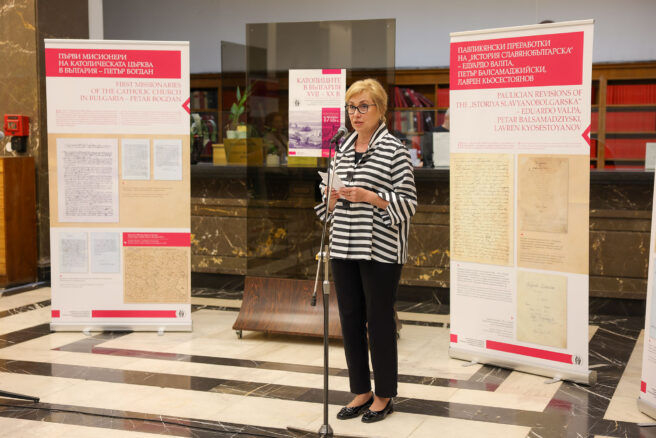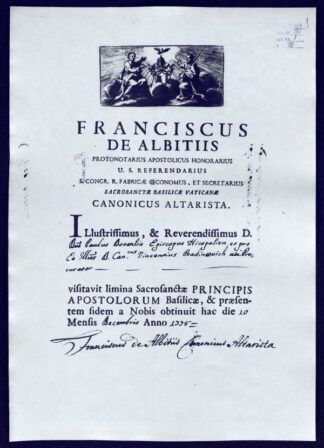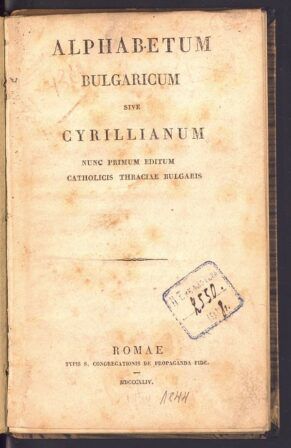On 17 April, the bilingual exhibition “Catholics in Bulgaria XVII-XX century”, with textual and archival sources from the collections of the National Library of Bulgaria, was officially opened in the central foyer of the library. In her opening remarks, the Director of the National Library, assoc. prof. Krasimira Aleksandrova, noted that this year marks the 350th anniversary of the death of the three notable Catholics of Bulgarian origin: Petar Bogdan Bakshev, Philip Stanislavov and Petar Parchevich. They contributed to the development of the cultural processes of the Bulgarian people during the XVIIth century, continued the preservation of the Bulgarian national identity and formed a circle of followers who continued their literary activity in the following centuries.
The exposition is arranged in chronological-thematic order and presents archival documents, old printed books, manuscripts and maps from the National Library’s collections, which illustrate the large-scale literary activity of Catholics of Bulgarian origin during the era of national revival. The archival documents are in several languages such as: Italian, Latin, Bulgarian and Ottoman Turkish. Geographical maps visualise the scope of action of the individuals included in the exhibition and clearly show the irrevocable presence of Bulgaria on the map of Europe throughout the centuries, regardless of the complex historical circumstances. The historical figures, whose work is presented in the exhibition, were well-educated and attended papal colleges and universities. Therefore, they were able to incorporate the contemporary literary advancements of the period into their own writings.
Petar Bogdan Bakshev (Bakšić) studied in Chiprovtsi, his native town, and then in Ancona – Italy. In 1623, he pursued further education at Clementine College until 1627. By 1630, he was elected as a curator at the Council of the Bulgarian Catholic Custody in Chiprovtsi, and by 1640, he embarked on his renowned journey through the Balkan regions of the Ottoman Empire, providing detailed descriptions of many settlements inhabited by Bulgarians. Together with other Catholics from Chiprovtsi, such as Petar Parchevich, he actively participated in the spiritually motivated uprising against Ottoman rule in 1688. At the same time, he developed a literary activity and was among the brightest members of Bulgaria’s pre-enlightenment intellectual elite. His most famous work is “On the Antiquity of the Fatherland and on Bulgarian Affairs”, which is the first historical treatise on Bulgarian native history during this period.
Philip Stanislavov studied at the Illyrian College in Loreto. In 1635, he was appointed as a translator for Pope Urban VIII, and the following year he was sent as a missionary to the Bulgarian lands. In 1648 he was elected as a bishop of the Nikopol diocese, and in 1651 he established a school in the village of Tranchevitsa. In the same year, he published his famous “Abagar” in Rome.
Pavel Gaidadzhisky Duvanliyata studied in Rome and at the Illyrian College in Loreto, and then received higher education again in Rome. In 1777, he was ordained as a bishop of the Catholic Diocese of Nikopol. He resided in Belene and Ruse. He developed active literary activity and was the first to base poetry on folklore elements.
Eusebius Fermenjin with the real name Martin Lukov Fermenjin (1845, Vinga – 1897, Našice, Croatia) is a historian, a member of the The Croatian Academy of Sciences and Arts, a descendant of Bulgarian immigrants in Vinga, a teacher in the Franciscan school in Baja. He is the first Bulgarian scientist to be awarded the title of “academic”. His collections of documents are a valuable testimony of ecclesiastical, demographic and cultural history.
The exhibition includes copies of the first printed books for Catholics of Bulgarian origin – the primer of Jacobus Jakovsky, books explaining the doctrine of the Catholic Church in an accessible, spoken language.
Three revisions of “Istoriya Slavyanobolgarskaya”, written in Latin, but again in the spoken language, illustrate that the text of Paisius of Hilendar was disseminated among the Bulgarian Paulicians.
Throughout this bilingual exhibition all visitors will be able to trace the development of cultural processes among Catholics of Bulgarian origin in the period from the XVIIth to the XXth century. The information panels introduce new insights, altering some previously established facts and providing novel information regarding the literary contributions of these individuals within both European and global aspects. The exposition will remain in the library until May 9th. Afterwards, the National Library intends to continue it as a traveling exhibition, which will be able to visit other cultural and educational institutions.



